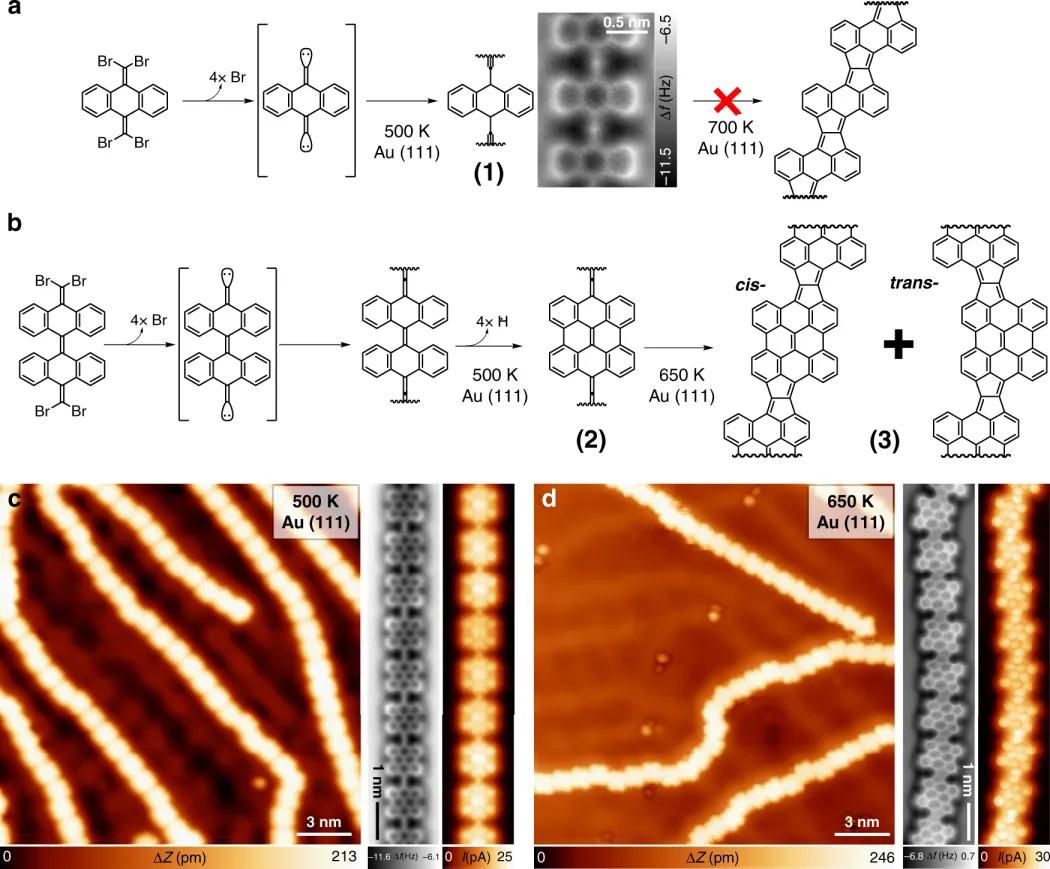In the Nature Communications, Czech scientists in collaboration with their colleagues from Spain introduced a new type of polymers which have been unavailable by means of traditional methods applied so far. This polymer type could play an important part in the design of new components for nanoelectronics, such as new displays. At the same time, the researchers proved that molecular vibrations significantly influence the course of reactions on solid surfaces and can be used for purposive synthesis of conductive polymers.
The development of the new synthesis strategy which surpasses traditional methods of organic synthesis was a joint effort of scientists from the Regional Centre of Advanced technologies and Materials (RCPTM) of the Palacký University Olomouc, the Institute of Physics of the Czech Academy of Sciences and IMDEA Nanociencia centre in Madrid.
“This method allows us to prepare new polymers and at the same time it disrupts existing notions of reaction mechanisms,” Pavel Jelínek from the RCRTM and the Institute of Physics of the Czech Academy of Sciences commented on the results.
A promising direction for the preparation of new nanomaterials based on organic molecules is chemical synthesis on solid surfaces which allows the preparation of conductive organic polymeric compounds unavailable by conventional methods of organic synthesis. Most chemical reactions aimed at the formation of new chemical compounds require overcoming a certain energy barrier. The new strategy enables the purposive use of suitable internal vibrations of molecular units to overcome them.
“In the article, we have demonstrated that there are certain vibration states corresponding to the specific internal arrangement of the bonds, the so called p-conjugation, of molecules entering into a reaction which can be suitable for the required chemical reaction. They significantly increase the frequency of attempts to overcome the energy barrier and allow for a chemical reaction that would have been previously impossible," said the corresponding author Bruno de la Torre from RCPTM and the Institute of Physics of the Czech Academy of Sciences.
The work of the international team thus reveals the importance of internal molecular vibrations for understanding chemical reactions on solid surfaces. In general, the feasibility of a chemical reaction is determined by two factors – the barrier of the activation energy of the reaction and the attempt frequency of vibration modes which allow to overcome the energy barrier.
New alternative – acceleration of some chemical reactions
The current description of a chemical reaction rate is based on the so-called transition state theory, which in its basic form defines a reaction rate only on the basis of the character of activation energy. Therefore, most chemists have focused on studying the activation energies in an effort to reduce them so that a chemical reaction can proceed successfully. In practice, the temperature is commonly raised and a catalyst is added to overcome the activation energy. Another alternative now is the possibility to accelerate some chemical reactions by increasing the attempt frequency to overcome the energy barrier.
“By combining microscopic experiments and theoretical calculations, we confirmed that by choosing a specific form of π-conjugation of the reactant, i.e. the molecule entering a reaction, vibration regimes can be achieved that significantly increase the attempt frequency and allow chemical reactions impossible before," explained doctoral student Adam Matěj from the RCPTM and the Institute of Physics of the Czech Academy of Sciences.
Scientists managed to determine the precise electronic structure of a polymer
Another benefit of the work is the fact that the researchers using high-resolution atomic force microscopy were able to accurately determine the electronic structure of a polymer. “Clarifying the electronic structure of organic conductive nanomaterials is essential to understanding their properties, such as conductivity. New methods of surface synthesis then open the way for purposive synthesis of organic polymers with the required conductivity," added Michal Otyepka from the RCPTM.
The new synthetic strategy based on the use of specific vibrational regimes by means of the appropriate adaptation of π-conjugation of precursors can thus stimulate the engineering of previously unfeasible reactions of new molecular structures with specific chemical and physical properties.
Contact persons:
Pavel Jelínek
Institute of Physics of the Czech Academy of Sciences and RCPTM
Email: jelinekp [at] fzu [dot] cz
Michal Otyepka
Faculty of Science Palacký University Olomouc, RCPTM
Email: michal [dot] otyepka [at] upol [dot] cz
doi.org/10.1038/s41467-020-18371-2
